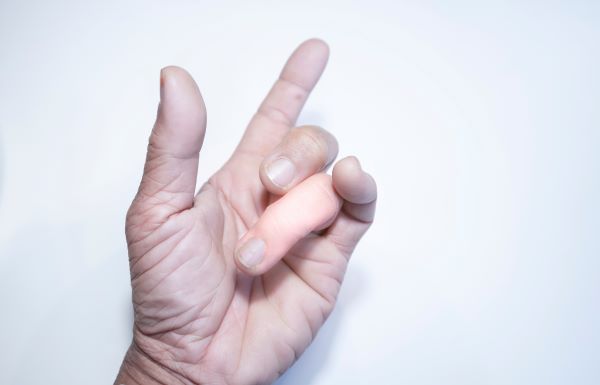Have you ever felt a popping or snapping sensation in your fingers when you bend or straighten them? Do you experience stiffness, pain, or a locking sensation in your fingers that makes it difficult to perform everyday tasks? If so, you may be one of the millions of people worldwide who suffer from trigger finger.
Trigger finger is a prevalent hand condition that affects up to 2.6% of the general population. While it is not a life-threatening condition, trigger finger can be a significant source of discomfort and can interfere with daily activities. Fortunately, with the right diagnosis and treatment, individuals with trigger finger can experience significant relief and return to their normal daily routine with ease.
But what is trigger finger? What causes it? What are the symptoms of trigger finger, and how can they be resolved? In this article, we’ll address your concerns, delving into the world of trigger finger by discussing its symptoms, potential causes, risk factors, and treatment options. Whether you’re currently experiencing trigger finger or simply want to learn more about this common hand condition, read on to discover everything you need to know to take charge of your hand and finger health.
What is Trigger Finger?
To understand trigger finger, it’s important to first understand the anatomy of the finger and hand. The tendons in your fingers are responsible for connecting the muscles in your forearm to the bones in your fingers, allowing you to move them. When you bend or straighten your fingers, these tendons glide smoothly through a protective sheath, ensuring proper movement.
However, when the tendons become inflamed and swollen, they can develop nodules or bumps, making it difficult for them to glide smoothly through the sheath. This results in the tell-tale popping or snapping sensation that are so often associated with trigger finger. The indicative symptoms of trigger finger may also extend to stiffness and pain in the affected finger, as well as a persistent locking or catching sensation.
The stiffness and pain associated with trigger finger can be quite uncomfortable, making it difficult to perform everyday tasks such as grasping objects or typing on a keyboard. If left untreated, trigger finger can also lead to more severe symptoms, such as the inability to fully straighten the affected finger.
If you’re experiencing the symptoms of trigger finger, it’s important to seek medical attention from a qualified professional right away. With the right diagnosis and treatment plan, you can manage your symptoms and get back to your normal daily routine with ease.

What Causes Trigger Finger?
While the condition is widely recognised and diagnosed, it’s not fully understood what causes trigger finger. Nevertheless, medical experts believe it to be related to inflammation and thickening of the tendon sheath which leads inhibits movement and creates the characteristic popping or snapping sensation of trigger finger.
Whilst the specified cause of the condition has not yet been clarified, there are several risk factors to watch out for that can increase your likelihood of developing trigger finger. Repetitive strain or overuse of the fingers is a common cause of trigger finger, particularly in individuals that perform repetitive hand motions on a regular basis, with office workers, assembly line workers and musicians at risk. Medical conditions such as diabetes, rheumatoid arthritis, and gout have also been associated with an increased risk of developing trigger finger.
Age and gender are also inherently related to the development of trigger finger. The condition is more common in women than in men, and it tends to affect individuals over the age of 40. This is likely due to the fact that tendons naturally become less flexible with age, making them more susceptible to injury and inflammation.
Trigger Finger Prevention: Nipping It in the Bud
While trigger finger may seemingly develop spontaneously, it may be comforting to know that simple changes to your daily routine can help you prevent trigger finger from developing. One effective prevention strategy is to make ergonomic modifications to your work and home environment. This might include making adjustments to your computer and keyboard height, using a comfortable grip when using tools or utensils, and keeping your wrist in a neutral position when typing or writing.
Taking frequent breaks and stretching your fingers and hands can also help prevent trigger finger. Gentle stretching exercises such as making a fist and then opening your hand wide or bending your fingers back towards your wrist can help keep your tendons flexible and prevent inflammation. It’s also important to stretch your fingers before engaging in any repetitive hand motions, such as playing an instrument or typing on a keyboard.

It’s also important to address any underlying medical conditions that may be associated with trigger finger, such as diabetes or rheumatoid arthritis. Properly managing these conditions can help reduce your risk of developing trigger finger and other hand-related issues.
By taking a proactive approach to hand and finger health, you can prevent the development of trigger finger and maintain optimal hand function. Incorporating ergonomic modifications, taking frequent breaks, stretching your fingers and hands, and addressing underlying medical conditions can all help you prevent trigger finger and other hand-related issues.
Trigger Finger Treatment: From Conservative Approaches to Surgery
Whilst there is a range of helpful preventative measures that you can take to minimise your risk of developing trigger finger, complications can sometimes be inevitable. In these instances, it’s important to understand the various treatment approaches that are available to help you overcome the condition. In less severe cases, this may be in the form of more conservative non-surgical approaches, but in more severe cases, surgery may be required.
Non-Surgical Treatment
Non-surgical treatments typically include rest, splinting, and activity modification to reduce strain on the affected finger. Over-the-counter medications such as non-steroidal anti-inflammatory drugs (NSAIDs) can help reduce pain and inflammation. Physical therapy and finger exercises can also help improve finger mobility and prevent the condition from worsening.
Surgical Treatment
If non-surgical treatments do not provide relief, trigger finger surgery may be necessary. Surgery is typically reserved for cases where the condition is severe, causing significant pain and functional impairment. During surgery, the surgeon will make a small incision in the palm of the hand and release the tight tendon sheath. This allows the tendon to move freely again, relieving the popping and snapping sensation associated with trigger finger.

After Care
After surgery, the patient will be given specific and personalised instructions on how to care for the surgical site and perform finger exercises to promote healing and prevent stiffness. The time necessary for a full recovery time can vary depending on the type of surgery and the patient’s individual healing process.
Whether you need to treat trigger finger conservatively or more significantly with surgery, it’s important to seek specialist medical attention as early as possible to prevent the condition from worsening and to maintain optimal hand function. With the right treatment plan, individuals with trigger finger can experience significant relief and return to their normal daily routine with ease.
Alleviate Your Trigger Finger Pain & Discomfort Today!
Trigger finger can be frustrating and challenging condition to face, but there are multiple approaches available to help alleviate symptoms and improve hand function.
Whether it’s through lifestyle changes, non-surgical interventions, or surgical procedures, it’s important to explore all available options and work closely with a qualified healthcare provider to determine the best course of action for you. If you’re struggling with trigger finger and need assistance, get in touch with Dr Stuart Kirkham from the Sydney Orthopaedic Surgeon Clinic. With his expertise and support, you can take the necessary steps towards achieving relief and improving your hand and finger health. Remember, your health and well-being should always be a top priority.


